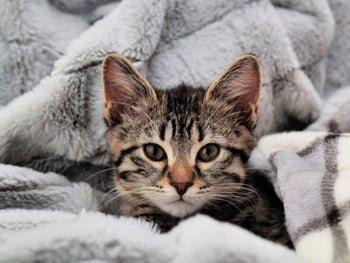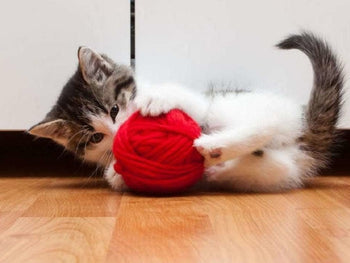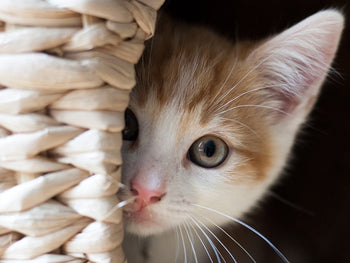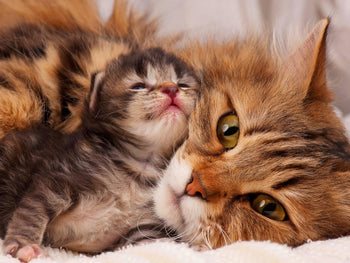
Subcutaneous fluids (also known as Sub-Q) is commonly used to prevent dehydration in cats that have diarrhea, pancreatitis, liver/kidney diseases and so on. Usually, veterinarians would handle the administering of Sub-Q to address acute conditions but for chronic illnesses, the vets often tell cat parents how to perform the procedure at home. All in all, people have to be feline experts just to give cats subcutaneous fluids. Nonetheless, one particular issue causes certain concerns among many pet owners: cat subcutaneous fluids leaking.
So you keep seeing leaks of fluids while giving your cat Sub-Q and want to know why it happens? Then this article right here should be useful to you. Down below, you shall be introduced to everything that you must remember about leaks of subcutaneous fluids in the felines.
Find out what to do when cat leaks brown fluid with CattyBox!
First And Foremost: Stay Calm

Overall, it's highly likely that once you see your cat subcutaneous fluids leaking, you would feel extremely worried and wonder if something is wrong. So let get one thing out of the way first: it's natural to see some leaks of fluids in cats after administering Sub-Q.
"Then what makes the fluids to come out?" you wonder. Well, as you inject subcutaneous fluids into the body of your fluffy friend, its fluid pressure temporarily increases a bit. As a result, small amounts of fluids inevitably trickle out of the needle entry but it's going to stop after the fluid pressure stabilizes. So, in essence, you have nothing to worry about besides wiping the leaking fluids clean. In addition to leaks of fluids, you might also see a small bulge right around the injection site but it should go away within 12 hours.
Happen to notice blood in the fluids that leak out? If that is the case then you must have hit a blood vessel during administering. Fortunately, the bleeding would come to halt within a few moments so don't panic.
Minimizing Leaks: The Ideal Approach

Despite the fact that leaks of fluids should be no cause for concern while administering Sub-Q, it's essential to control the leaking fluids. You give your furball subcutaneous fluids to help it with dehydration so if the fluids leak out too much then that ultimately defeats the purpose. To minimize the leaking fluids, it's strongly recommended that you lightly pinch your kitty for a couple of seconds after removing the needle. Also, gently massage the needle entry to keep the subcutaneous fluids from coming back out.
Check us out for various astonishing cat tips & facts!
Top 5 Frequently Asked Question About The Administering Of Sub-Q

-
How much fluid is needed?
Different cats have different requirements but in most cases, between 10 and 20 ml/kg of fluids could be given at a single injection site. As mentioned, a bulge is going to form under the skin around the needle entry. Normally, the bulge would disappear eventually as the body of the felines absorbs the fluids. That being said, if the bulge remains clearly noticeable at the next administering, it's necessary to contact the vets.
How often should the felines receive Sub-Q on average?
After assessing the conditions of the pets, veterinarians shall decide how often people have to give the felines subcutaneous fluids. A few cats must be administered Sub-Q daily while others only need to get the fluids once a week. The most common frequency of Sub-Q administering these kinds of days is 2 – 3 times weekly.
-
What do pet owners need to give cats subcutaneous fluids?
Generally speaking, you need to have 3 items on hand to give your fluffy friend Sub-Q: a fluid bag, a giving set and a needle.
- Fluid Bag: It's the one that contains the subcutaneous fluids that would go into the body of your furball during administering. For safety reasons, it's essential to avoid using bags that have cloudy/discolored fluids. Most fluid bags have two ports on them: an injection port and a giving port. Unless veterinarians ask you to mix in certain solutions before administering, you don't have to use the injection port. To minimize potential irritations to your cat, put the fluid bad in warm water for 5 – 10 minutes to make it lukewarm.
- Giving Set: It's a length of plastic tubing that is shielded by covers at both ends. To use the giving set, you must remove the covers. At one end is a white spike that would be inserted straight to the giving port of the fluid bag and the other end is where you attach the needle. To regulate the flow of fluids, the giving set tends to feature a roller clamp. Until the needle is firmly inserted into your cat, it's of utmost importance that you roll the clampdown to prevent losses of fluids.
- Needle: The hub of the needle would be attached to one end of the giving set. Keep the cover on top of the needle and only remove it prior to administering. Cat parents nowadays have several options regarding the needle gauge (19, 20, 21,...). As different gauges tend to make different entries, the choice of needle gauge would have considerable influences on the issue of cat subcutaneous fluids leaking.
-
Is it necessary to contain cats before giving them fluids?
All in all, mellow cats that happen to have a laidback temper would accept the procedure without making a fuss. Nonetheless, in the case your cat is slightly on the feisty side then you might want to contain it during the administering of Sub-Q. A towel-lined box is more than enough for most of the time but if you want something more, you could get specialized cat bags.
-
Do I have to worry about complications while administering fluids?
Assuming that you manage to follow the procedure exactly as advised by the vets then complications should be fairly uncommon. In most cases, you only see cat subcutaneous fluids leaking, negligible bleeding and so on. However, if your furball develops a swelling at the inject site which causes it great distress, notify your veterinarian as that could be an abscess.
Read more Cat's Health Guides and find fun stuff on Cattybox!









